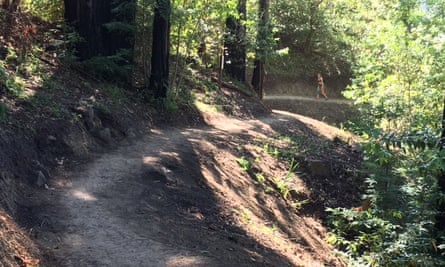A community on the stretch of coastal California known as Big Sur has been largely cut off from the outside world since winter storms collapsed a bridge to the north and triggered landslides to the south, blocking the sole road.
For residents who remain, the only way in and out – bar helicopter – is on foot, via a steep, rugged hiking trail carved out of forested slopes. From dawn till dusk they use it get to and from school, work, grocery stores and other amenities.
Six months of huffing and puffing later the Big Sur health center has noticed something: all the exercise is making people healthier.
“Every crisis has a silver lining,” said Sharen Carey, the executive director. “People have lost weight. They’re improving their cardiovascular system. They’re sleeping better.”
One patient who had diabetes, and declined medication, is all but cured, she said. “He was required to walk the trail five days a week. Since February he has lost 24lb. His numbers went from diabetic to pre-diabetic. His blood pressure is normal. On paper he’s just about normal.”
Another patient with diabetes, and one with pre-diabetes, also showed marked improvement, said Carey. Many other patients reported simply feeling better and more energised.
“They’re getting outdoors and working. The ones who have lost weight have reported that they’re more energetic. Sleep, blood pressure, heart rate, they all benefit.”
The trail was a mile and a half – a three-mile round trip. That comprised about 4,000 steps which burned approximately 200 to 300 calories, said Carey, citing her Fitbit. “It doesn’t sound like much but it’s not just about burning calories, it’s getting your heart rate working.”

Residents interviewed on the trail agreed. John and Frances Hoeffel, retired lab technicians in their 70s, said they enjoyed the hike. They were returning from the library.

Others reported an additional benefit: commuting on foot via a narrow, winding trail rather than driving on the Pacific Coastal Highway has bolstered their sense of community.
“It’s been a leveller,” said Erin Gafill, whose family owns the Nepenthe restaurant. “We all have to walk that trail together. You get a sense of each other’s routines. We’re not as separated.” Long-term residents had newfound respect for how hard Latinos – who juggle multiple jobs – work, she said.

Her mother, Holly Gafill, agreed. “That trail is so intimate. You’re almost touching people if not hugging them because you haven’t seen them in ages. I look at the trail with so much gratitude.”
Few saw a bright side when torrential storms buried the highway in massive mudslides and washed away the Pfeiffer Canyon bridge, cutting off segments totalling 35 miles along Big Sur, a scenic coastal ribbon between San Francisco and Los Angeles which draws 3 million tourists a year.
The isolation has devastated hotels, restaurants and resorts, inflicting job losses and hardship.
Not all residents enjoy hiking the trail which emergency crews carved out of the hillsides in February.
“I find it pretty arduous, but then I’m overweight and I smoke cigarettes,” said Bill Crain, 56. “I paid a guy $50 to bring my cats back from the vet.”

Other neighbours grumbled too, he said, despite the benefit: “They may not like it but it’s good for them.”
Cubans experienced a similar phenomenon but on much more dramatic, painful scale in the 1990s when the economy collapsed, slashing food and gasoline consumption.
A new bridge is expected to open in September, restoring the tourist flow and letting residents once again drive to schools and amenities.
Yet the unexpected positive side effects of isolation have made some almost wistful about the experience. “I’ll be sort of sorry to see the bridge go back up,” said Carey. “We’re all hiking that trail all the time, but next year how many will still do it?”
Gafill, the restaurant owner, said the stillness and quiet harked back to the area’s bohemian 1950s era. “There will be a sense of loss when we go back (to normal) because we’ve gained so much – a return to a time when you had time.”
